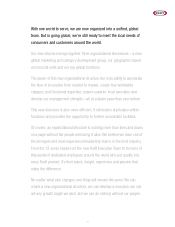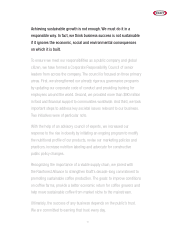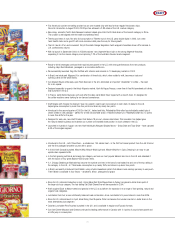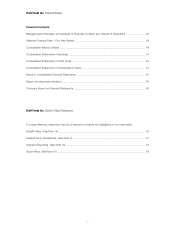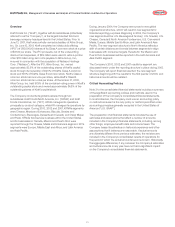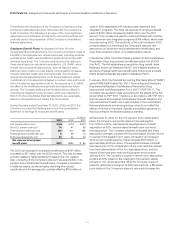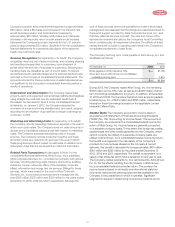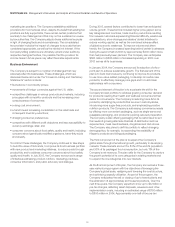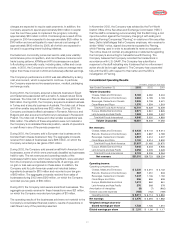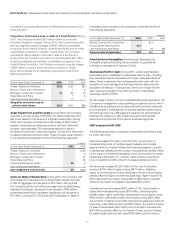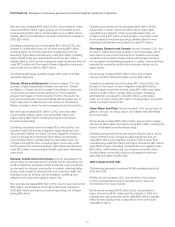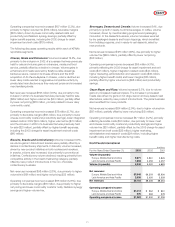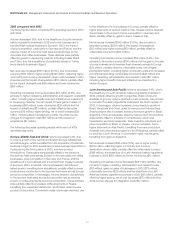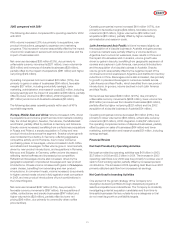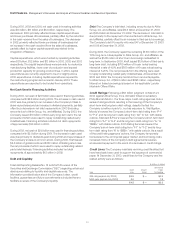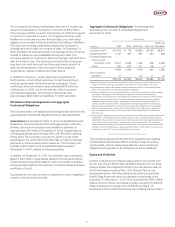Kraft 2003 Annual Report Download - page 28
Download and view the complete annual report
Please find page 28 of the 2003 Kraft annual report below. You can navigate through the pages in the report by either clicking on the pages listed below, or by using the keyword search tool below to find specific information within the annual report.
Kraft Foods Inc. Management’s Discussion and Analysis of Financial Condition and Results of Operations
evaluating tax positions. The Company establishes additional
provisions for income taxes when, despite the belief that existing tax
positions are fully supportable, there remain certain positions that
are likely to be challenged and that may not be sustained on review
by tax authorities. The Company adjusts these additional accruals
in light of changing facts and circumstances. The consolidated
tax provision includes the impact of changes to accruals that are
considered appropriate, as well as the related net interest. If the
Company’s filing positions are ultimately upheld under audits by
respective taxing authorities, it is possible that the provision for
income taxes in future years may reflect favorable adjustments.
Business Environment
The Company is subject to a number of challenges that may
adversely affect its businesses. These challenges, which are
discussed below and under the “Forward-Looking and Cautionary
Statements” section include:
• fluctuations in commodity prices;
• movements of foreign currencies against the U.S. dollar;
• competitive challenges in various products and markets, including
price gaps with competitor products and the increasing price-
consciousness of consumers;
• a rising cost environment;
• a trend toward increasing consolidation in the retail trade and
consequent inventory reductions;
• changing consumer preferences;
• competitors with different profit objectives and less susceptibility to
currency exchange rates; and
• consumer concerns about food safety, quality and health, including
concerns about genetically modified organisms, trans-fatty acids
and obesity.
To confront these challenges, the Company continues to take steps
to build the value of its brands, to improve its food business portfolio
with new product and marketing initiatives, to reduce costs through
productivity and to address consumer concerns about food safety,
quality and health. In July 2003, the Company announced a range
of initiatives addressing product nutrition, marketing practices,
consumer information, and public advocacy and dialogue.
During 2003, several factors contributed to lower than anticipated
volume growth. These factors included higher price gaps in some
key categories and countries, trade inventory reductions resulting
from several customers experiencing financial difficulty, warehouse
consolidations, store closings and retailers’ stated initiatives to
reduce working capital, as well as the combined adverse effect
of global economic weakness. To improve volume and share
trends, the Company increased spending behind certain businesses
during the second half of 2003 by approximately $200 million more
than had previously been planned. The Company also anticipates
$500 million to $600 million of increased spending in 2004 over
2003 across all its businesses.
In January 2004, the Company announced its adoption of a four-
point plan to achieve sustainable growth. The first element of the
plan is to build brand value by continuing to improve its products,
to use more value-added packaging, to develop innovative new
products, to effectively manage price gaps and to build closer
relationships with consumers.
The second element of the plan is to accelerate the shift in the
Company’s brand portfolio to address growing consumer demand
for products meeting their health and wellness concerns and their
desire for convenience. The Company is reducing trans-fat in its
products, identifying its products that are low in carbohydrates,
introducing more sugar-free products, and emphasizing positive
nutrition products. The Company is addressing convenience needs
by offering more convenient packaging, such as single-serve and
resealable packaging, and products requiring reduced preparation.
The Company is also offering packaging that is customized to suit
the needs of growing alternate channels of distribution such as
supercenters, mass merchandisers, drugstores and club stores.
The Company also plans to shift its portfolio to reflect changing
demographics, for example, by expanding the availability of
Hispanic products and bilingual packaging.
The third component of the plan is to expand the Company’s
global scale through international growth, particularly in developing
markets. These markets account for 84% of the world’s population
and 30% of its packaged food consumption, but only 11% of the
Company’s net revenues. The plan calls for the Company to capture
the growth potential of its core categories in existing markets and
to expand its core categories into new markets.
As the final component of its plan, the Company announced a three-
year restructuring program with the objectives of leveraging the
Company’s global scale, realigning and lowering the cost structure,
and optimizing capacity utilization. As part of this program, the
Company anticipates the exit or closing of up to twenty plants and
the elimination of approximately six thousand positions. Over the
next three years, the Company expects to incur up to $1.2 billion in
pre-tax charges, reflecting asset disposals, severance and other
implementation costs, including an estimated range of $750 million
to $800 million in 2004. Approximately one-half of the pre-tax
26



